JANUARY 15, 2009 — As our plane landed in Punta Arenas, Chile, the southernmost city of its size in the world, my brother Brian desperately uttered, “Get me out of this aluminum tube.” For a self-professed lover of plane travel in particular, this was an uncharacteristic request, but I understood. We had been flying for fifteen hours on our way to tackle the 130-kilometer (81-mile) Torres del Paine Circuit in the Patagonia region of southern Chile, and we had made the mistake of wearing our sweltering hiking boots on our flights. With six hours of bus travel still ahead of us, we were not oblivious to the cosmic humor of having to spend an entire night and day jammed into tiny economy-class-sized spaces so that we could eventually spend nine days hiking through wide-open spaces of wilderness.
After a turbulent landing in the notorious Patagonian winds, we rode in the driver’s cab on a full bus to backpacker’s-haven Puerto Natales, where we bought our final supplies for our trip. Quickly, we learned the Spanish vocabulary for sunscreen (“proteccion solar”), insoles (“plantillas”), and camping stove fuel (most strangely, “bencina blanca,” or “white spirit”). Two striking Chilean girls whom we had met on our flight met us for dinner at Afrigonia, a restaurant described as “African-Patagonian fusion” on our guide map. I can’t attest to the accuracy of the description of this fusion, but the chicken curry tasted delicious after our long trip. We discovered quickly that our Chilean friends had never been on a major hiking or camping trip before, and they feared that their aspirations to hike the full Torres del Paine Circuit outstripped their abilities. After all, most casual hikers who visit Torres del Paine National Park hike a route called “The W,” which can be completed in four days and doesn’t require hikers to carry a tent or food, if they choose to overnight at comfortable “refugios” along the route. Despite the girls’ borrowed, ill-fitting equipment and lack of experience, we were impressed with their courage. Sometimes the best way to learn how to become an astronaut is to borrow a space suit and beg NASA to fire you into outer space on a rocket.
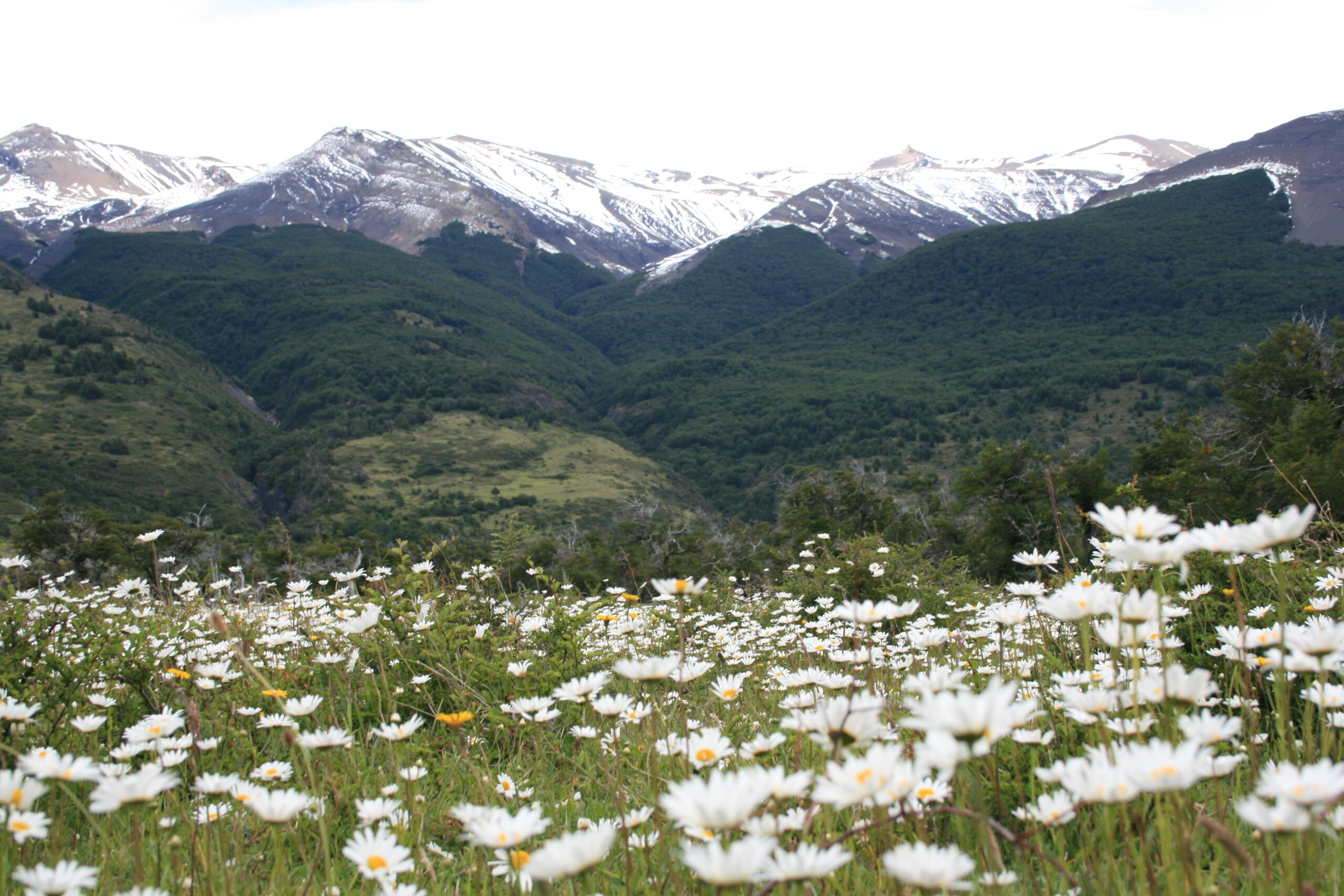
Kilometers of fields of daisies in Torres del Paine National Park in Chilean Patagonia.
The girls latched onto us after another three-hour bus ride the next morning, and the four of us began trekking through the kilometers of daisy fields that started our hike. Though my brother and I were nervous that the hike’s seemingly auspicious and effortless beginning eventually would be mocked by friends from home hoping to hear stories of death-defying adventure, we appreciated seeing the meadows of white petals and dramatic snow-capped mountain backdrops after so much time spent trapped in aluminum tubes.
Yet even the tranquil fields of white flowers were too much for our Chilean friends; their oversized backpacks distributed the weight of their cargo to the wrong places (their shoulders) despite a detailed pack-strap-tightening class my brother and I taught. At our first campsite, the girls collapsed, completely immobile, after only about 17 kilometers (11 miles) of the hike. Not helping their spirits were rumors flying around camp that a hiker had died that day trying to hike a difficult mountain pass in a blizzard, a pass which we knew we would have to tackle as part of the Circuit. After inhaling lots of spaghetti and cigarettes, the girls began chatting with other hikers at the campsite, trying to find anyone willing to carry the contents of their backpacks for the remainder of the adventure.
My brother and I also began meeting other hikers. I helped an 18-year-old high school valedictorian from New Zealand named Brittany carry a heavy tree stump to a circle of stump-seats already arranged by her family. Suddenly, I found myself in a Kiwi interrogation circle — two families from New Zealand, with three teenage girls and four parents, were throwing out tens of questions in their distinct accents about my job, my brother, and what life was like as an American with an annual pass to Disneyland. Apparently, to New Zealand teenagers, meeting someone with an annual pass to Disneyland is as exciting as meeting Miley Cyrus in person.
After the most audacious daughter, 14-year-old Megan, almost killed me for making the mistake of lumping New Zealanders and Australians together, the kids invited me and my brother to play the Rummy-like card game Phase 10 with them. During the game, Megan also attacked me for not pronouncing her name correctly — with a Kiwi accent, it’s pronounced “Mee-gan.” Soon, Brian and I found we couldn’t open our mouths without being assaulted from all sides for not using correct Kiwi vocabulary. We started talking about “hiking,” and the New Zealander girls yelled “tramping” at the top of their lungs. We mentioned “sandals” and they screamed “jandals.” We said “swimsuit” and they shriked “togs.” Perhaps most entertaining, we chatted about “trail mix” and they immediately shouted “scroggin.”

A Chilean hiker looks out at Lago Paine on the Torres del Paine Circuit.
While talking to the girls’ parents, I said something about the “buttercups” we had hiked through and immediately received a botany lesson from Mee-gan’s mother, a plant-expert. In Randy Pausch’s book The Last Lecture — a transcript of a final lecture given by a dying professor at Carnegie Mellon University — the author suggests that there are two types of families in the world: those who need a dictionary to get through a family dinner and those who can do without. These New Zealand families were the kind that wouldn’t be able to finish an appetizer without a 26-volume encyclopedia.
We quickly learned to speak carefully around these rambunctious teenagers, especially Mee-gan, who frequently managed to start arguments about the way we accented certain syllables in certain words. Brittany, fascinated by our stash of freeze-dried camping food, begged to watch as we made our dinner and demanded to taste every meal or snack we ate. Mee-gan’s 16-year-old sister Ella was more mysterious than the other two, as she sat quietly, seemingly waiting for the right moment to strike. That moment usually never came, but the longer she sat, the more her mischievous silence unnerved us.
Yet all of their unique personalities were intensely endearing, and after the Chilean girls bravely catapulted ahead of us without their heavy backpacks to weigh them down — amazingly, they found other hikers to carry their equipment — we found ourselves hiking with the Kiwi teenagers and their parents.
The girls were enthralled (we thought) with our refined ability to entertain them on the trail; after all, my brother and I have spent hundreds of hours on other trips perfecting word games, memory games, and board games for amusement both during hiking and while settling into our tents at night.
We were on a bizarre family vacation — embedded into other people’s families.
When the Kiwi parents asked us to keep watch over the girls when they strayed too far ahead into the extreme Patagonian winds and my brother and I began throwing sticky-burrs at the girls on the trail like long-lost siblings, it became clear — as we tramped, ate our scroggin, and received our daily botany lessons, the two New Zealand families had implicitly adopted us, and we had become honorary Kiwis.
An expanded, icy-cold definition of adventure
A father takes his teenage daughter on a final trip to Patagonia.
JANUARY 20, 2009 — The only thing standing between us and views of 270-square-kilometer Glaciar Grey was Paso John Garner, a steep and rocky pass through the Patagonian Andes Mountains. My brother Brian and I looked up nervously at the severe mountain crags and glacial ice surrounding us, and though we hadn’t been able to substantiate the rumors of a lost hiker’s death during a blizzard in the pass three days before, the gossip made us uneasy. We knew that some hikers had turned back, failing to conquer the pass due to dangerous weather.
The New Zealand families with whom we had been hiking didn’t seem worried. At the bottom of the pass, with the help of the amazing Gorillapod camera tripod, the nine of us took a “family” photo, with the parents, teenagers, Brian, and me grinning from ear-to-ear. Then we started hiking up the pass.
These ambitious Kiwis were surprisingly tough. My family’s vacations were never this intense. Gordon, the 68-year-old father of 18-year-old Brittany, had spent his young adult life mountaineering in Patagonia, summiting many uncharted and never-before-climbed peaks. Sadly, his wife Jackie told me he had a rare disease, which affected his knees, making it difficult for him to walk. The family was rushing on as many adventures as possible, before his legs became totally debilitated. Their planned trip combined the Torres del Paine Circuit with another Patagonian escapade, a reunion of Gordon’s old mountaineering buddies, for the family adventure of a lifetime.

Hikers admire the view of Glaciar Grey on the Torres del Paine Circuit in Chilean Patagonia.
As most of her teenage friends probably were sitting in their bedrooms, messaging cute boys on Facebook and reading Seventeen, tireless Brittany and committed Gordon trekked up the craggy pass, through cold rain and wind strong enough to blow hikers off the trail. Most impressive, neither father nor daughter complained once — not about the near-freezing temperatures; not about the extreme wind gusts; and not about the sleet that occasionally pelted us in the faces. In fact, keeping pace with Brittany and her gung-ho attitude was a challenge for Brian and me as we trudged up the mountain. Even in the most difficult conditions, this girl treated every trek experience — whether entertaining, uncomfortable, or tedious — as an “adventure.”
Thankfully, despite the cold, wind, and sleet, the weather was surprisingly cooperative — in Patagonia, this means only that we weren’t hit by a terrifying tornado or a lethal lightning strike — and we reached the top of the pass with surprisingly little difficulty.
From the top, we looked out over a magnificent expanse of bluish-grey, crevasse-covered ice, sparkling like crystal in the Patagonian sun. From above, the cream-colored frozen water looked like the result of God spilling an enormous and delicious vanilla milkshake into the Patagonian valley below. Brittany, never showing any signs of fatigue, jumped onto my back for a piggyback ride as my brother took our photo in front of the epic ice cream river. Even the air smelled sweet.
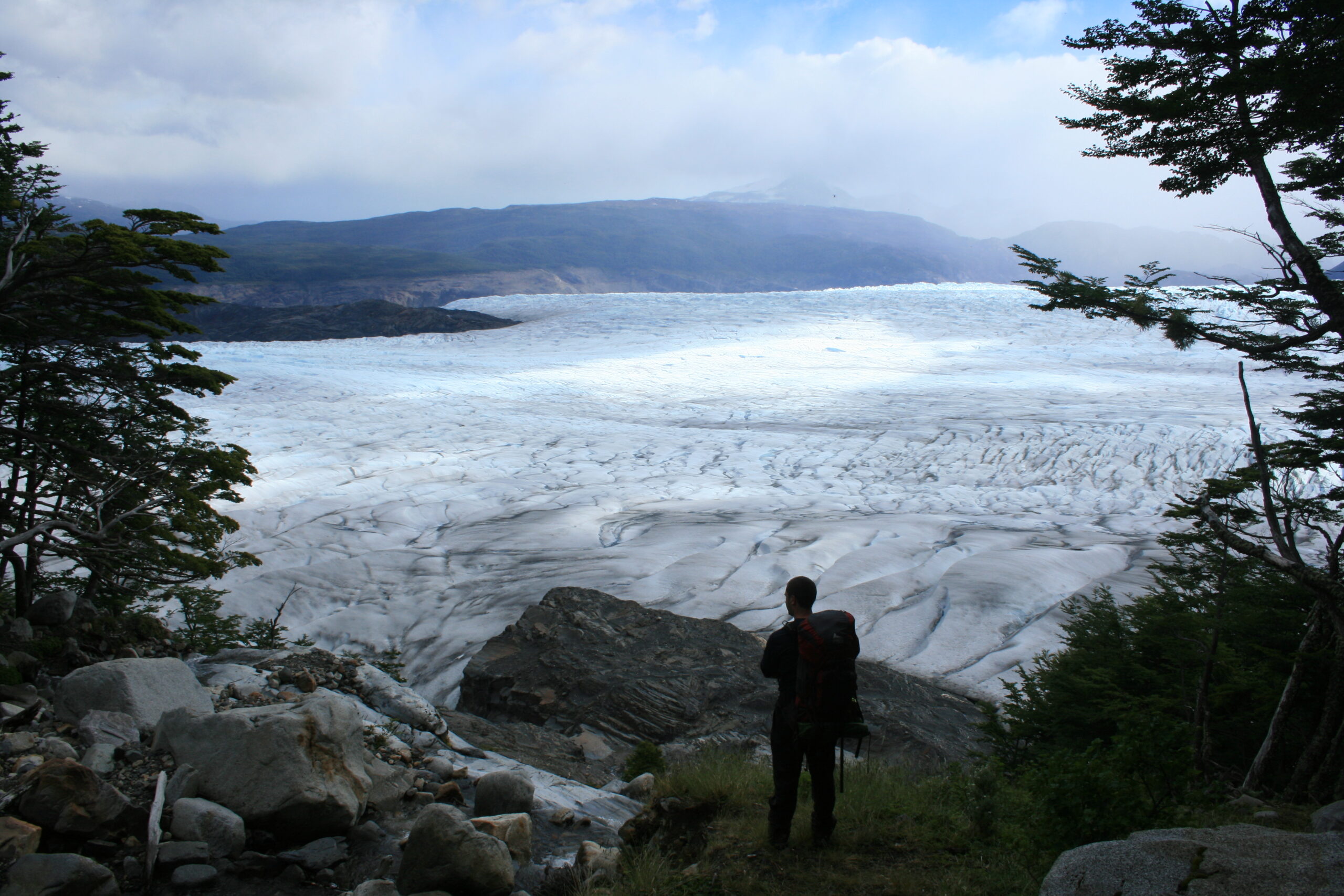
A hiker gazes out over Glaciar Grey. (photo by Brian Leukart)
I watched as Gordon looked out at the vista and then hiked past us, deliberately moving toward the massive glacier as if pulled by strong, invisible strings.
It was more fulfilling seeing this 68-year-old adventurer gaze at the stunning glacial view than it was to see it myself.
I stood still for a while, taking photographs of Gordon and the rest of the hiking group, as they made their way down the other side of the pass toward the ice. I knew that no photograph could possibly justly capture the sight of the silhouettes of two generations, Gordon and Brittany, in front of the blinding backdrop, but I tried anyway.
Sitting adjacent to the shimmering ice in perhaps the most picturesque picnic location in the world, we ate our lunch of sausage and cheese. When we finished, we hiked toward the glacial terminus, a glacial lake filled with floating icebergs severed from the melting glacier. The teenage girls, Brian, and I bounded toward the lake, and despite my previous harrowing experience with glacial water, I chose an iceberg near the shore that looked like it could hold my weight. I tested its stability with my carbon fiber hiking poles, and it didn’t budge. Carefully, I stepped out onto the floating mass of ice, and Brittany yelled out, begging to join me. She bounced onto the ice, and we posed together as Brian took our picture.

Hank and Brittany walk along the shore of Lago Grey at dusk. (photo by Brian Leukart)
The events that followed are embarrassingly obvious. Brittany’s arrival caused the iceberg to begin rolling in the water. She let out a yelp and leapt to the safety of the rocky beach, causing the iceberg to rotate faster. Quickly, my legs slid into the near-freezing glacial lake as I clung desperately to the jagged ice with my hands, trying not to fall completely into the water. Just when I thought I had avoided total submersion, the damned berg rolled one more time and suddenly, I was swimming in a glacial lake, wearing hiking boots and two layers of insulation.
Shivering, I slogged out of the water, only to be greeted by three hysterically laughing teenage girls and the repeated mechanical sound of the rapid-fire shutter on my brother’s camera. Soaking wet, I admitted that I had gotten what I deserved. I’ve never seen teenage girls look so delighted. Taking advantage of my disorientation, they convinced me to record a mock commercial on their camera, starring me, touting the remarkable ability of my Marmot jacket to dry quickly and keep me warm after falling into a glacial lake. I worry about the day that the video finds its way to YouTube.
That night, as dusk faded, Brian decided to try to shoot some night-photos on the shores of Lago Grey near our campsite. Brittany, ever energetic and buoyant, begged to join us on “another adventure.” Despite our insistence that long-exposure photographs with a tripod hardly constituted an “adventure,” she joined us on our walk to the water. As my brother tinkered with the camera, Brittany and I walked along the rocky shore toward a tiny wooden dock sitting on the water. A supernatural palette of Patagonian blues enveloped us as we gazed at the lake, and the camera captured us under a navy sky, two blurry, ghost-like figures in the darkness.
Soon after, Brittany pleaded with me to go swimming in the glacial waters with her, this time intentionally. She shrieked as I picked her up and threw her into the lake. Then Brian pushed me in as he jumped in himself. As we hit the icy water, adrenaline rushed through our bodies.
Brittany had inherited an amazingly broad sense of adventure from her father, Gordon. At that moment, Brian and I inherited it from her.
A Patagonian ghost story
Brothers face their deepest fears in Chile’s Valles de Frances.
JANUARY 29, 2009 — “You know, when hikers get lost and die, it’s always on these day-hike side trips,” I said to the teenagers from New Zealand as my brother Brian and I were leaving for a hike to the enigmatic Valles de Frances. Every Torres del Paine guidebook insists upon hiking the side-trip, but none manage to adequately explain why the valley is unique compared to the rest of the Circuit — they only use cryptic words like “famous” and “must-see.” I admit that my comment to the girls was mostly my shorthand version of a hiking ghost story, but that’s what an adopted older brother does to his younger Kiwi sisters, especially as rumors continued to surface about a hiker disappearing in a blizzard at the Torres del Paine Circuit’s mountain pass.
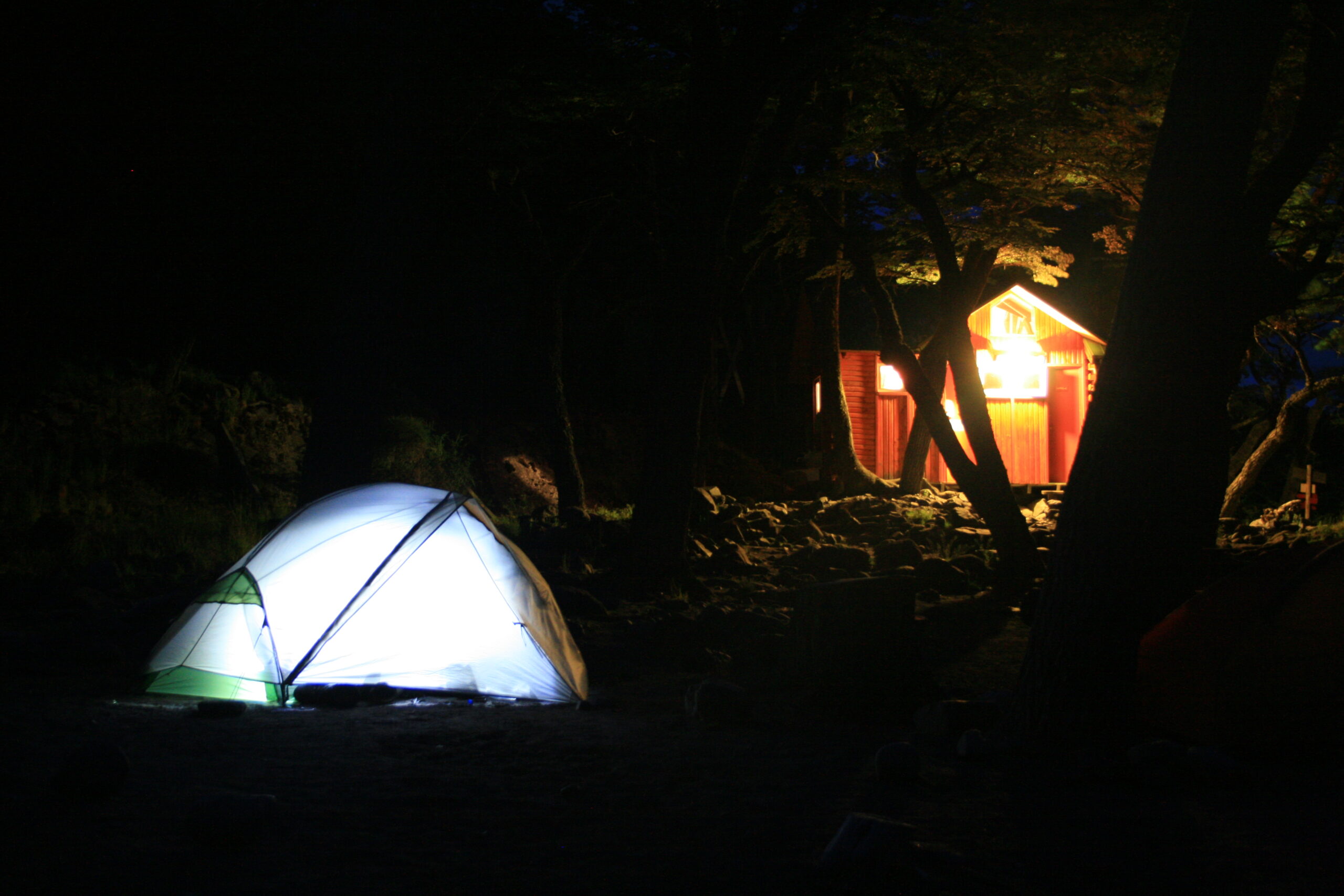
Night falls on campers at Campamento Grey in Torres del Paine National Park, Chile. (photo by Brian Leukart)
“It’s pissing down,” one of the girls said in a thick New Zealand accent, explaining why their families had decided (smartly) to stay behind from the side trip and try to wait out the rain storm.
But Brian and I had a limited amount of time in Patagonia, and this was a once-in-a-lifetime chance to see whatever the heck was up there. Sadly, we said goodbye to the New Zealand teenagers and their parents. Then, I put a GPS navigator, first-aid kit, water, and food into a daypack — unprepared hikers in ghost-stories always die lost, with a broken arm, and without sustenance — and we began the trek through the “piss.”
As we walked up the steep mountain, the cold, relentless sleet began soaking my daypack and seeping through our breathable rain gear. Frustrated, I began to marvel at how I had ended up in Patagonia without a backpack rain cover.
On my first multiday backpacking trip, I was so clueless that I didn’t know to bring a rain cover. In Alaska, I forgot to bring one, and on Vancouver Island, I brought one too small to fit my pack. Thankfully, for Patagonia, I remembered to bring a cover, and miraculously, it fit my pack. But on our second day in Chile, the 100-kmh Patagonian wind literally blew one of our Chilean friends off the trail and into a rock as we neared the top of a small mountain pass. When we made it over the pass and around a bend, as the choppy, turquoise waters of Lago Paine came into view, the wind suddenly ripped my improperly secured rain cover off of my backpack. Horrified, I turned around and watched the cover fly erratically over dense underbrush and down the steep crag. Foolishly, I began sprinting toward it but came to an obvious realization: I couldn’t run as fast as wind. Exhausted and helpless, I watched as the cover slowly became a small gray speck against the bright blue Chilean sky, soaring down the mountain and across a lush green valley, eventually disappearing.

Chilean flags wave at dusk near Paine Grande in Torres del Paine National Park. (photo by Brian Leukart)
So, as rain drenched my daypack, soaking its contents and making it heavier, I began to wish we had stayed behind with the New Zealanders. After hiking uphill for about 90 minutes, we came across some exhausted Israeli hikers whom we had met at earlier campsites, and my brother asked one of them how much time we had until we reached the top.
“It’s only about 30 more minutes,” the Isareli said. “But… it’s nothing. Just… nothing.” Then he abruptly continued down the trail, leaving us bewildered.
The Israeli had seemed confused and scared. Was there really nothing at the top? What did he mean? We wondered whether, at the top of the Valles de Frances, hikers were forced to face their deepest fears, like the plot of a science fiction-horror movie. When we reached the top, would I fall yet again into glacial water and float down an infinite glacial river? Would my brother come face-to-face with an army of killer bullet ants, our family’s go-to example of a person’s scariest possible demise? Did the Israeli reach the top, only to find himself lost in a terrifying expanse of non-existence?
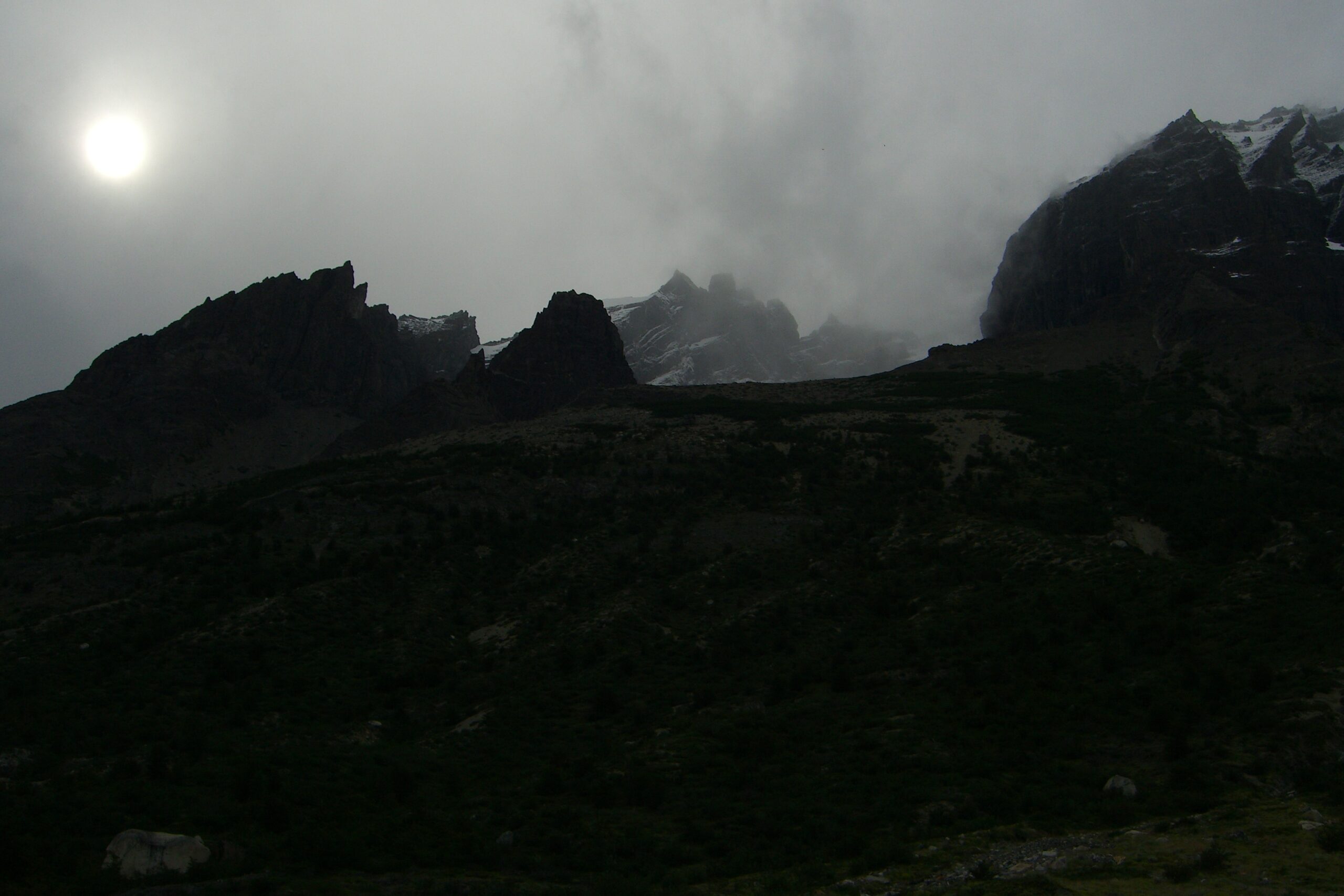
Cloud-covered mountains in Chilean Patagonia.
Nevertheless, we hiked onward, half-wondering whether we were hiking toward a physical manifestation of future failure in our careers or our inability to be loved.
Then, suddenly, we stopped seeing the bright-orange trail markers helping us find our way. The GPS navigator showed us off-trail, but we couldn’t seem to locate the trail again. I took my digital camera out of its supposedly-protective Ziploc bag to take a photo, but it displayed inscrutable error messages on its waterlogged display and wouldn’t function. Was the Valles de Frances some kind of strange Patagonian Bermuda Triangle? Were we about to discover a treasure trove of Nazi submarines, extra terrestrials, and Amelia Earhart’s corpse? If so, there wouldn’t be any photographic evidence to prove it.
Under a tree canopy on the side of the mountain, my brother and I ate our only two Clif Bars in the freezing rain.
“We’re going to die up here,” he joked. I laughed and looked up toward a raging glacial river as hail began to fall from the sky.
As we stood in weather seemingly stolen from a Discovery Channel special titled, “God’s Wrath,” we saw a gray dot in the distance, getting larger as it moved toward us. Quickly, the object came close enough for us to identify, and we watched incredulously as my backpack rain cover blew past us, carried by the strong Patagonian wind.
With the wind whistling in our ears, we began chasing after the seemingly enchanted cover toward the Valles de Frances, feeling strongly that when fate and a magical valley reunites you with a long-lost item, you do everything you can to take advantage of the opportunity. As we sprinted across the valley, surrounded on all-sides by dramatic mountain peaks, we heard a soft, rhythmic moaning. At first, we mistook it for the whistling of the wind, but as we ran desperately after the airborne pack cover, always only two steps from grabbing it, the moaning grew louder and more despairing, until we were sure it was coming from a person.
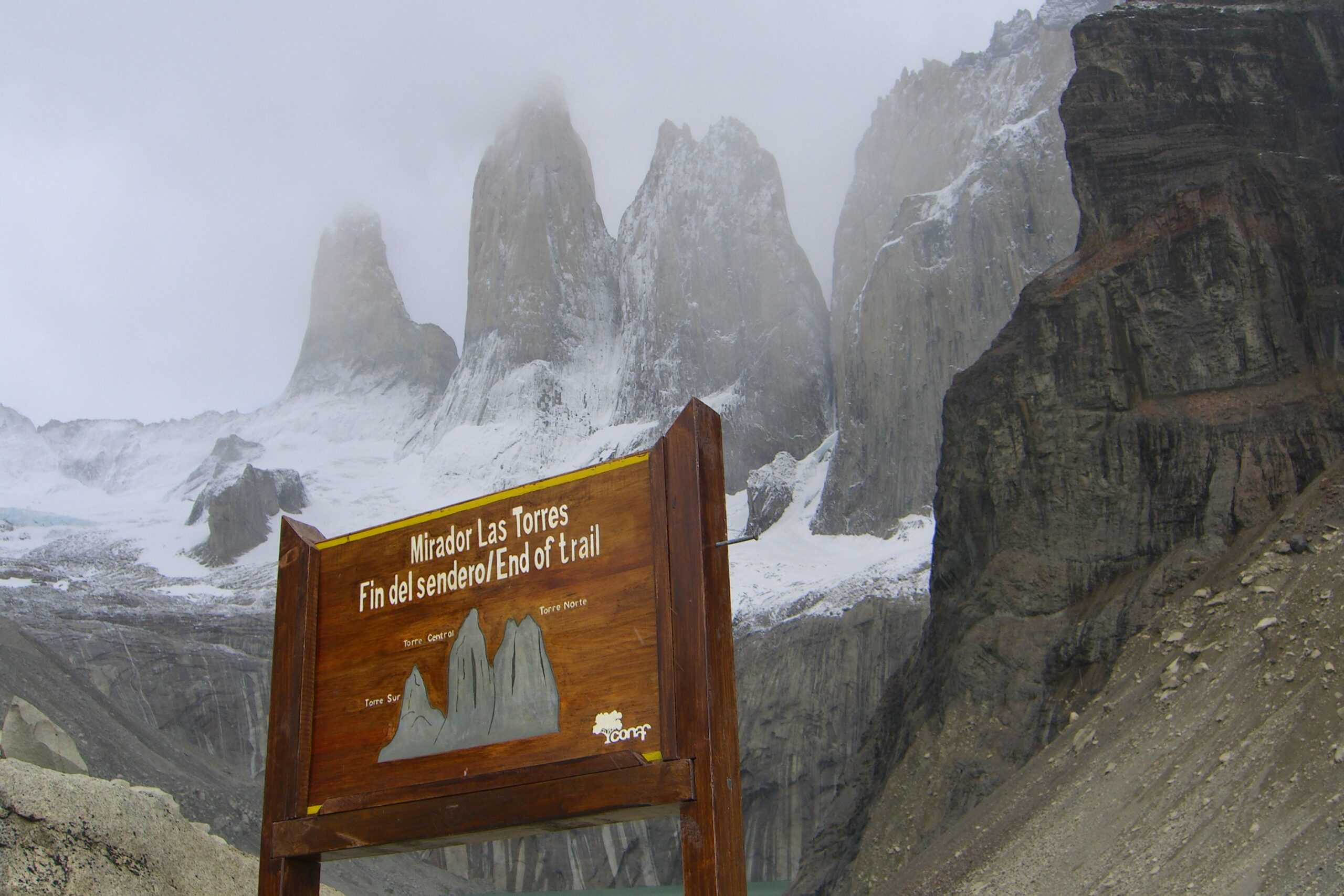
An end-of-trail sign greets hikers below the Torres del Paine in Chilean Patagonia.
The flying cover led us around a towering, foreboding rock formation shaped like an enormous ice axe, when finally, we stumbled upon a pale-faced hiker lying on the ground. Covered in frostbite, with blood seeping from scrapes and broken limbs, the sounds of his inhuman moaning were deafening.
“Always go hiking well-prepared,” he rasped as he took his last breaths. “And always bring a backpack rain cover.”
Or at least, that’s how it happened in my ghost story.
In reality, after we ate our Clif Bars, we rediscovered the trail and made it to the top of the Valles de Frances only to see a disappointing mountain view, hampered by freezing rain and an overcast sky. I vowed never to hike without a backpack rain cover again.
But after returning from Patagonia, my brother and I read a newspaper with the real story of Ronan Lawlor, an Irish hiker who disappeared on the Torres del Paine Circuit, as rumored. Indeed, he had ventured on a side trip by himself, slipped on a rocky incline, and fell to his death. He was later found dead by the Chilean military while we were hiking in the park.
Even the best ghost story lessons can’t prepare you for everything.
How to Hike the Torres del Paine Circuit
Fly to Punta Arenas, Chile on LAN Airlines. Note that USA and Canadian citizens must pay a $130 (US) “reciprocity fee” to enter the country.
Buy a ticket on a bus to Puerto Natales and then on to Torres del Paine National Park. Try the Bus-Sur bus company. You will probably want to stay overnight in Puerto Natales. Try Hostel Melissa for an inexpensive $30 (US) room for two people with a private bathroom and breakfast the next morning.
When you arrive at the park, pay the small entrance fee $15 (US) and begin hiking from Laguna Amarga or Refugio Las Torres. To do the full Torres del Paine Circuit with both side trips (to the Valle de Frances and to the Torres del Paine), you will want at least eight full days of hiking if you’re a strong hiker, or ten full days if you want to take it easy. For a much easier and shorter (four to five day) hike, try hiking “The W.”
Bring clothing and hiking equipment to handle variable and extreme weather, including freezing temperatures, high winds, rain, sleet, hail, snow, and hot sun. You will also want to carry some Chilean pesos to buy treats or extra hot meals at the refugios along some of the route.
View the route below or download the Without Baggage Torres del Paine GPS track in GPX format.
Excellent story about an excellent trip, well written.
I hope you can share some details with me. How heavy was your pack? Did you carry food for all 9-10 days of trekking?
Hi Ilya,
I don't know exactly how heavy our pack was, but I think it was in the range of 50 pounds at the beginning. Yes, we carried all the food we needed for the entire trip, but you can avoid that — at least for part of the trip — by eating at the refugios. However, this can be expensive.
Very well written – I enjoyed reading your article immensely. I am going to the circuit in around a month myself, right after I hike/climb to the top of Aconcagua.
Anyone here do both the Torres del Paine and the West Coast Trail in Canada?
Would love to hear if they are at all comparable in difficulty
I have done both Torres del Paine and West Coast Trail. They're hard to compare because they're so different, but I think that the West Coast Trail is more taxing. You have to carry all of your own food and shelter (Torres del Paine has huts/refugios along much but not all of the route where you can sleep and eat if you prefer), there are hundreds of long ladders to climb, and you have to deal with high tide schedules, cable cars, and dangerous surge channels. But, the full Torres del Paine circuit is longer and getting there is much more complicated (assuming that you're coming from the US).
You can read all about my West Coast Trail hike here: <a href='http://withoutbaggage.com/trips/west-coast-trail/'>withoutbaggage.com/trips/west-coast-trail/</a>
Great story! I really enjoyed reading it. What time of year did you do the circuit? I am planning a trip in October or November and am trying to see if I might encounter the same weather conditions as you did.
I already had the opportunity to go in the mountain range only in Paraguay and the cold is very intense, you need to be well prepared. When I went, I was accompanied by a guide. Congratulations on the article.